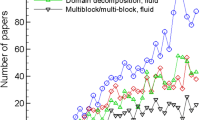Abstract
We describe how modular software design and well proven object oriented design patterns can help to implement a flexible software package for the efficient solution of partial differential equations. Today not only efficiency in the numerical solution is of utmost importance for practical use, efficiency in problem setup and interpretation of numerical results is of importance if modeling and computing comes closer and closer together. In order to demonstrate the possibilities of the software, we apply the tool to several non-standard problems.
Similar content being viewed by others
References
Ainsworth M. and Oden J. (2000). A posteriori error estimation in finite element analysis. Wiley, New York
Banas K. (2005). On a modular architecture for finite element systems. i sequential codes. Comput. Vis. Sci. 8: 35–47
Bänsch E., Haußer F., Lakkis O., Li B. and Voigt A. (2004). Finite element method for epitaxial growth with attachment-etachment kinetics. J. Comput. Phys. 194: 409–434
Bänsch E., Morin P. and Nochetto R. (2005). A finite element method for surface diffusion: the parametric case. J. Comput. Phys. 203: 321–343
Barrett J. and Blowey J. (1999). Finite element approximation of the Cahn-Hilliard equation with concentration dependent mobility. Math. Comp. 68: 487–517
Bastian, P., Droske, M., Engwer, C., Klöfkorn, R., Neubauer, T., Ohlberger, M., Rumpf, M.: Towards a Unified Framework for Scientific Computing. LNCSE. Springer, Berlin Heidelberg New York (2005, Accepted for publication)
Bertalmio M., Cheng L.T., Osher S. and Sapiro G. (2001). Variational problems and partial differential equations on implicit surfaces. J. Comput. Phys. 174: 759–780
Bornemann F. and Rasch C. (2006). Finite-element discretization of static Hamilton–Jacobi equations based on a local variational principle. Comput. Vis. Sci. 9: 57–69
Clarenz U., Haußer F., Rumpf M., Voigt A., Weickard U. (2006) On level set formulations for anisotropic mean curvature flow and surface diffusion. In: Multiscale Modeling in epitaxial growth, ISNM, vol. 149, pp. 227–237. Birkhäuser, Boston (2005)
Feng X. and Prohl A. (2005). Numerical analysis of the Cahn–Hilliard equation and approximation for the Hele–Shaw problem. Interf. Free Bound. 7(1): 1–28
Fried E. and Gurtin M. (2004). A unified treatment of evolving interfaces accounting for small deformations and atomic transport with emphasis on grain-boundaries and epitaxy. Adv. Appl. Mech. 40: 1–177
Fried M. (2004). A level set based finite element algorithm for the simulation of dendritic growth. Comput. Vis. Sci. 7(2): 97–110
Gamma, E., Helm, R., Johnson, R., Vlissides, J.: Design Patterns. Addison-Wesley, Reading (1996)
Hackbusch W. and Sauter S. (1997). Composite finite elements for the approximation of PDEs on domains with complicated micro-structures. Numer. Math. 75: 447–472
Halpern D., Jensen O. and Grotberg J. (1998). A theoretical study of surfactant and liquid delivery into the lung. J. Appl. Physiol. 85: 333–352
Haußer, F., Voigt A. (2005). Facet formation and coarsening modeled by a geometric evolution law for epitaxial growth. J. Cryst. Growth 275: e47–e51
Haußer, F., Voigt, A.: Anisotropic surface diffusion, a numerical approach by parametric finite elements. J. Sci. Comput. (2007) DOI 10.1007/s10915-005-9064-6
Kim J., Kang K. and Lowengrub J. (2004). Conservative multigrid methods for Cahn–Hilliard fluids. J. Comput. Phys. 193(2): 511–543
Memoli F., Sapiro G. and Thompson P. (2004). Implicit brain imaging. Human Brain Mapping 23: 179–188
Myers T. and Charpin J. (2004). A mathematical model for atmosheric ice accretion and water flow on a cold surface. Int. J. Heat Mass Trans. 47(25): 5483–5500
Osher, S., Fedkiw, R.: Level Set Methods and Dynamic Implicit Surfaces. Springer, Berlin Heidelberg New York (2003)
Rätz, A., Ribalta, A., Voigt, A.: Surface evolution of elastically stressed films under deposition. J. Comput. Phys. 214, 187–208 (2006)
Sapiro, G.: Geometric partial differential equations and image analysis. Cambridge University Press, Cambridge (2001)
Schmidt, A.: A multi-mesh finite element method for phase-field simulations. In: Interface and Transport Dynamics, LNCSE, vol. 32, pp. 209–217 (2003)
Schmidt, A., Siebert, K.: Design of Adaptive Finite Element Software, LNCSE, vol. 42. Springer, Berlin Heidelberg New York (2005)
Sethian, J.: Level Set Methods and Fast Marching Methods. Cambridge University Press, Cambridge (1999)
Smereka P. (2003). A level set based finite element algorithm for the simulation of dendritic growth. J. Sci. Comput. 19: 439–456
Stöcker C., Vey S. and Voigt A. (2005). AMDiS-adaptive multidimensional simulation: composite finite elements and signed distance functions. WSEAS Trans. Circ. Syst. 4: 111–116
Turk, G., Levoy, M.: Zipped polygon meshes from range images. In: SIGGRAPH’94, pp. 311–318 (1994)
Verfürth, R.: A review of a posteriori error estimation and adaptive mesh refinement techniques. Wiley-Teubner, Chichester (1996)
Author information
Authors and Affiliations
Corresponding author
Additional information
Communicated by K. Mikula.
Rights and permissions
About this article
Cite this article
Vey, S., Voigt, A. AMDiS: adaptive multidimensional simulations. Comput. Visual Sci. 10, 57–67 (2007). https://doi.org/10.1007/s00791-006-0048-3
Received:
Accepted:
Published:
Issue Date:
DOI: https://doi.org/10.1007/s00791-006-0048-3




